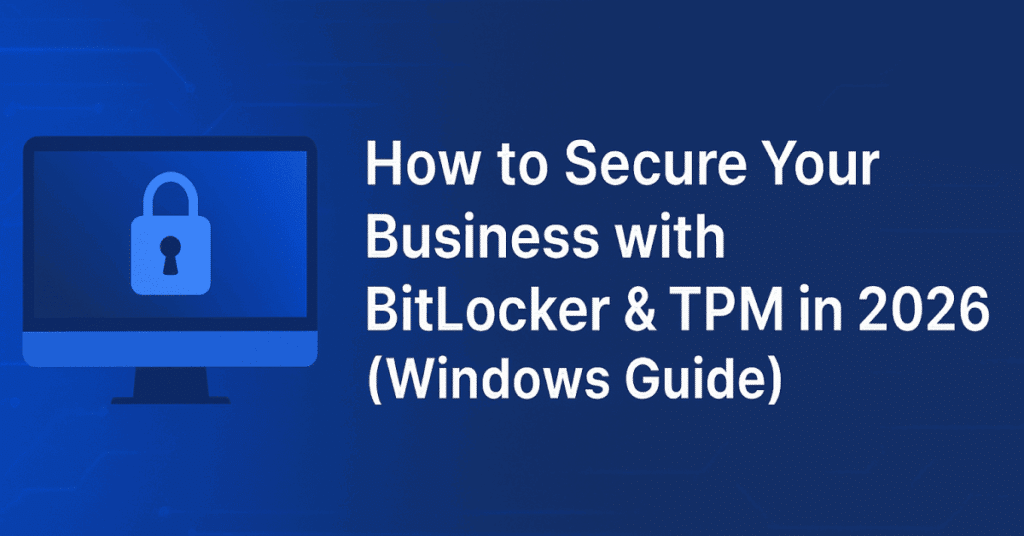Understanding BitLocker: The Modern Data Security Standard
As businesses move deeper into the digital world, data security has become a non-negotiable priority. In 2026, cyber-attacks, phishing attempts, and ransomware threats continue to rise, especially for small and medium-sized companies. That’s where BitLocker, Microsoft’s built-in encryption tool, becomes one of the most important security layers your company can use.
What BitLocker Actually Does
BitLocker encrypts the entire drive on your device so that if someone steals your laptop, removes the hard drive, or tries to access it without permission, the data stays locked and unreadable. Only authorized users can unlock it.
Why Encryption Matters in 2026
With remote work becoming the norm, laptops travel everywhere—homes, cafés, airports, co-working spaces. Losing a device shouldn’t mean losing confidential data. BitLocker ensures your files stay protected, no matter where your team works.
The Role of TPM 2.0 in Business Security
To make BitLocker stronger and more reliable, Windows uses a hardware security chip called TPM 2.0 (Trusted Platform Module). Think of it as a tiny, smart lock inside your computer that stores secure keys and protects them from hackers.
How TPM Protects Sensitive Information
TPM:
- Stores your encryption keys safely
- Prevents attackers from bypassing security
- Checks your system integrity during startup
- Blocks unauthorized attempts to access your drive
TPM 2.0 vs Older Versions
TPM 2.0 is faster, smarter, and supports modern encryption standards. It is required for:
- Windows 11 Pro
- Windows 12 Pro (expected in 2026)
- BitLocker device encryption
- Secure Boot
- Zero-trust security frameworks
If your business is upgrading hardware in 2026, choosing devices with TPM 2.0 is crucial.
Why Windows 11/12 Pro Is Essential for Business Security
With Windows 11 and the upcoming Windows 12, Microsoft has invested heavily in enterprise-level security. The Pro editions include advanced protections that Home editions simply don’t offer.
Built-In Enterprise Security Features
Windows 11/12 Pro includes:
- BitLocker with TPM integration
- Secure Boot and virtualization-based security
- Windows Defender SmartScreen
- Group Policies for managing teams
- Mobile Device Management support
Why Pro Editions Matter
If you run a business, the Pro editions give you:
- Better control over employees’ devices
- Stronger encryption
- Remote security management
- Enhanced device authentication
Simply put, Windows Pro is designed for business security from the ground up.
Step-by-Step Guide: Setting Up BitLocker with TPM
Let’s walk through how to secure your business devices using BitLocker and TPM in 2026.
Step 1: Check TPM Availability
- Press Windows Key + R
- Type tpm.msc
- Look for Status: The TPM is ready for use
If you don’t see it, your TPM may be disabled or missing.
Step 2: Enable TPM in BIOS/UEFI
Restart your device and open BIOS/UEFI settings.
Look for:
- TPM Security
- Security Chip
- Intel PTT or AMD fTPM
Turn it On, then save and exit.
Step 3: Turn On BitLocker in Windows
- Open Settings
- Go to Privacy & Security → Device Encryption / BitLocker
- Click Turn on BitLocker
- Select how you want to unlock the drive (PIN, password, USB key)
Step 4: Save and Manage Your Recovery Keys
You can save the recovery key:
- To your Microsoft Account
- To USB
- To a file
- To Active Directory (for businesses)
Never lose this key. Without it, you can permanently lose access to your data.
Step 5: Monitor Encryption Status
Windows will begin encrypting your drive in the background. You can check progress anytime in the BitLocker Management panel.
Best Practices for Securing Business Devices in 2026
Use Strong Authentication Policies
Require:
- PINs or passphrases
- 2-step verification
- Device login policies
Manage Recovery Keys for Teams
Use a secure, centralized storage solution such as:
- Active Directory
- Microsoft Entra ID
- Encrypted cloud storage
Choose Business-Ready Hardware
In 2026, ideal business devices include:
- TPM 2.0 built-in
- SSD drives (faster encryption)
- Windows 11/12 Pro compatibility
Common Issues & How to Fix Them
BitLocker Not Detecting TPM
This usually means TPM is disabled.
Solution: Enable it in BIOS under Security Settings.
Devices Stuck in Recovery Mode
Often caused by:
- Hardware changes
- BIOS updates
- Incorrect boot settings
Solution: Enter your recovery key, then update TPM settings.
BIOS Compatibility Errors
Older machines may need BIOS/UEFI updates.
➡️ Solution: Download the latest BIOS update from your PC manufacturer.
Final Thoughts
Securing your business devices in 2026 doesn’t have to be difficult. With BitLocker, TPM 2.0, and Windows 11/12 Pro, you gain a strong security foundation that protects your data, your team, and your customers.
Following the steps in this guide ensures your business stays safe in a world where cyber threats are constantly evolving.
FAQ: BitLocker, TPM & Windows Business Security
1. Do I need TPM 2.0 to use BitLocker?
Yes, for full security and compatibility with Windows 11/12 Pro, TPM 2.0 is required.
2. Is BitLocker included in Windows Home?
No, BitLocker is available in Windows Pro editions only.
3. Can I use BitLocker on external drives?
Yes — BitLocker To Go allows encryption on USB drives.
4. What happens if I lose my recovery key?
You may permanently lose access to your data. Always back it up securely.
5. Does encryption slow down my PC?
On modern SSDs, the performance impact is minimal.
6. Can BitLocker protect devices in a remote workforce?
Absolutely — it’s one of the best protections for off-site employees.

